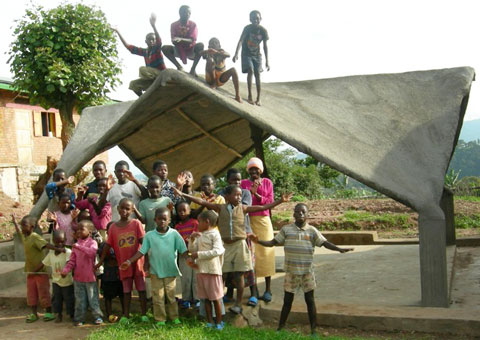Solution of the week 8
Constructing low-cost water tanks with ferrocement
When I say ‘water tank’, what image is conjured up in your mind? Is it one of those large black plastic tanks which you see so frequently in developing countries, usually perched on top of a small tower or on a roof? Millions of those are used around the world, so that image would be very appropriate. When I say ‘water tank’, however, I think of something else entirely. I think of ferrocement: the best, strongest, durable, cheapest, and most versatile construction material I know. And I think of the water tanks I have built myself, using it.
The term ‘ferrocement’ refers to cement reinforced with some sort of steel, be it thin wire, wire mesh or thicker reinforcement bars. Cement is great in withstanding pressure, but not very good in withstanding tension forces. For steel wire it's exactly the reverse. A combination of the two yields an excellent construction material, which does not rust, rot or blow down in storms. Ferrocement is different from ordinary reinforced cement in that a lot more steel is used, along with a strong cement mixture. This leads to lightweight structures which can have almost any shape.

Boats, houses, statues
The ferrocement technique dates back to the times of Greek fresco making and the sculptural wire-and-plaster techniques of the times of Leonardo da Vinci, adapted to modern materials. Boats have been built with ferrocement, tanks (the military type), houses, statues, etc. With ferrocement, it is easy to construct earthquake resistant houses cheaply. Seeing the devastation in Haiti, it is a sad fact that this fireproof and earthquake-safe technique is so seldom used in modern construction.
Water tanks
Back to water tanks. Say, you need a 2 m2 ferrocement water tank for your rainwater harvesting system. The classical technique is to start with building a cage of steel reinforcement bars, covered with chicken wire mesh. An alternative is to start with an inner form of metal sheets, which is later removed. Or, for smaller tanks, a sack filled with sand is used. Once this structure is established, a cement mixture is applied. As ferrocement is much stronger than masonry, the thickness of the walls is in the range of 10-30mm. During curing (at least 10 days, although 30 is better) the cement is kept wet and wrapped in plastic sheet. Fill’r up, and enjoy.

Your tank will be a lot cheaper than a plastic tank, have a lifetime of at least 25 years, and is easy to repair in case of cracks. The technology is extremely simple to implement, and semi-skilled construction workers can learn it with ease. Such tanks have been used on a wide scale in Asia and in some African countries, and there is huge scope for increased use for rainwater harvesting systems.
Tanks take time
Are there any disadvantages? Well, they take quite some time to build, so they are too expensive for commercial application in the western world. But this is a great advantage for small-scale enterprises in developing countries, who can employ low-cost labour. Highly motivated ferrocement entrepreneurs around the world create aqueducts, water and septic tanks, drainage systems, large flower pots for hotels and parks, shade roofs, and small houses. The more the better, I say.
Links
- Other blogs in this series
- EMAS movies on (1) classical ferrocement tanks, (2) inner-form tanks, and (3) small tanks
- Wikipedia article on Ferrocement
- Making a large ferrocement tank
- Ferrocement boats
- Ferrocement.com: a bit rough, but a wealth of information
- Flying Concrete - lightweight concrete structures
